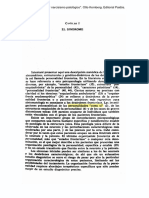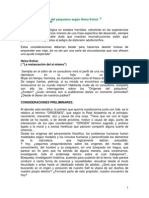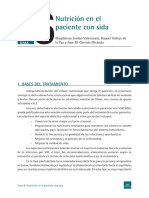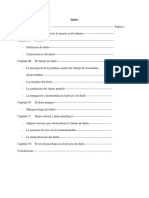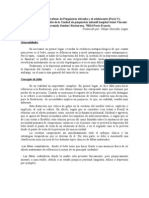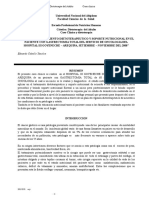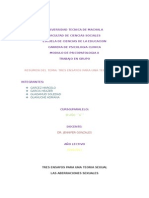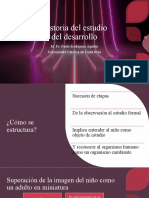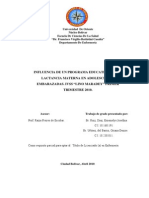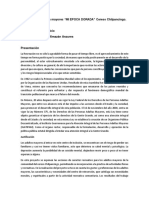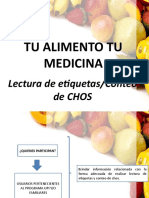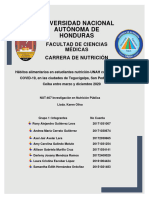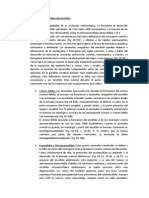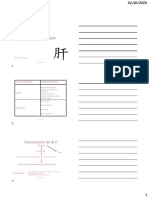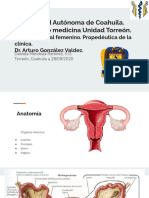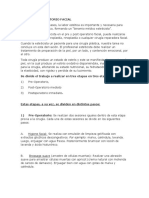Caquexia Oncologica
Caquexia Oncologica
Cargado por
Lorenzo GiggsCopyright:
Formatos disponibles
Caquexia Oncologica
Caquexia Oncologica
Cargado por
Lorenzo GiggsDescripción original:
Derechos de autor
Formatos disponibles
Compartir este documento
Compartir o incrustar documentos
¿Le pareció útil este documento?
¿Este contenido es inapropiado?
Copyright:
Formatos disponibles
Caquexia Oncologica
Caquexia Oncologica
Cargado por
Lorenzo GiggsCopyright:
Formatos disponibles
Sosa-Snchez y cols.
ARTCULO DE REVISIN
Sndrome de anorexia-caquexia
en el paciente oncolgico
Ricardo Sosa-Snchez,* Karla Snchez-Lara, Daniel Motola-Kuba y Dan Green-Renner
Centro Oncolgico Integral Diana Laura Riojas de Colosio, Fundacin Clnica Mdica Sur, Mxico D.F., Mxico
Recibido en versin modificada: 29 de noviembre de 2007 Aceptado: 14 de diciembre de 2007
RESUMEN SUMMARY
Se estima que dos terceras partes de los pacientes con cncer Approximately two thirds of cancer patients at advanced stages of
sufren anorexia o prdida significativa de apetito, lo que conduce the disease suffer from anorexia, which leads to significant weight
a prdida acentuada de peso y a desnutricin grave (caquexia), loss and progressive cachexia, an important factor that contributes
una de las principales causas contribuyentes de la muerte. Se ha to death. It has been observed that cancer cachexia differs from
observado que el sndrome de anorexia-caquexia en cncer difiere simple starvation, although the exact mechanisms associated with
de la desnutricin simple, si bien an no se conocen los mecanismos cancer cachexia are not well known. Several theories regarding its
exactos que lo ocasionan. Diversas hiptesis proponen que la pathogenesis point to a complex mixture of tumor, host and treatment
patognesis es multicausal, destacndose diversas caractersticas variables. Unfortunately, the wasting syndrome also constitutes for
del tumor, del husped y variables del tratamiento. Desafortunada- the patient, a progression of the cancer process, significantly
mente, con frecuencia la prdida acentuada de peso representa affecting quality of life and social interactions. Treatable causes
para el paciente la progresin del proceso de la enfermedad, lo que should be identified and treated. Knowledge of the mechanisms
puede tener repercusiones significativas en su calidad de vida y en underlying the effects of caquexia on the patient may play a role in
sus interacciones familiares y sociales. Se lleva a cabo una revisin identifying treatment measures targetted to muscle wasting and to
bibliogrfica de los procesos etiolgicos del sndrome, as como de maintain body strength. In this article we review the main features
las posibles medidas teraputicas y farmacolgicas. and mechanisms of the anorexia-cachexia syndrome in patients
with cancer.
Palabras clave: Key words:
Cncer, anorexia, caquexia, prdida de peso, Cancer, anorexia, cachexia,
prdida de masa muscular weight loss, mass loss
Introduccin incrementa de 50% a ms de 80% en etapas avanzadas o
terminales, siendo en ms de 20% de los pacientes la
L a anorexia, prdida del apetito o del deseo de comer,
es uno de los sntomas ms frecuentes en pacientes
con cncer;1 est presente en 15 a 25% de los individuos al
principal causa de muerte.7 Al tiempo del diagnstico, 80%
de los enfermos con cncer gastrointestinal y 60% de los
individuos con tumores malignos primarios de otros sitios,
tiempo del diagnstico y es casi universal en pacientes con tienen prdida de peso sustancial.8,9
enfermedad metastsica. Asimismo, es la causa ms comn Costa y colaboradores10 definieron el sndrome de
de reduccin de ingestin de alimentos, desencadenando anorexia-caquexia en pacientes con cncer como el resul-
desnutricin e inanicin progresivas2,3 (Cuadro I). tado de diversos cambios caracterizados por hipermetabo-
La caquexia se define como la prdida de peso y el lismo relativo, deplecin proteica y falla anablica propicia-
desgaste progresivo del msculo esqueltico y de la grasa, da por el consumo inadecuado de nutrimentos debido a la
incluso antes que la prdida de peso sea evidente;4 los anorexia. Se ha observado que la caquexia por cncer
pacientes con caquexia avanzada se caracterizan por ano- difiere de la simple prdida aguda de peso;11-13 se ha
rexia, saciedad temprana, prdida de peso severa, debili- demostrado que la desnutricin se asocia con reduccin de
dad, anemia y edemas.5 Se ha estimado que la mitad de la la respuesta al tratamiento,14 lo cual tiene un impacto
poblacin con cncer sufre caquexia;6 la prevalencia se importante en la calidad de vida del paciente, incluyendo
*Correspondencia y solicitud de sobretiros: Ricardo Sosa-Snchez. Centro Oncolgico Integral Diana Laura Riojas de Colosio, Fundacin
Clnica Mdica Sur, Puente de Piedra 150, Col. Toriello Guerra, Del. Tlalpan, 14050 Mxico D. F., Mxico. Tel.: (55) 5424 7200, extensiones 7232
y 7283. Correo electrnico: rsosa@medicasur.org.mx
Gac Md Mx Vol. 144 No. 5, 2008 435
(www.anmm.org.mx)
Sndrome de anorexia-caquexia
aspectos emocionales, as como en la morbilidad y morta- sntesis de protenas es ineficaz y el manejo de los depsi-
lidad.15 Con frecuencia se subestima su relevancia clnica tos de energa metablica est profundamente alterado;
e incluso se inician tratamientos solo en etapas avanzadas como resultado, el aporte de caloras y nutrimentos elemen-
de la enfermedad. tales no es capaz de estimular eficazmente la sntesis de
protenas.
Por otra parte, los cambios metablicos que ocurren
Patognesis durante el crecimiento tumoral son mediados por numero-
sos factores, entre ellos el factor de induccin de proteli-
Los mecanismos patognicos del sndrome de anorexia- sis, que induce la degradacin de protenas a aminocidos
caquexia asociado a cncer tienen un complejo origen en el msculo esqueltico, y el factor movilizador de lpidos,
multicausal.16 Por un lado, existen alteraciones metablicas que promueve la degradacin del tejido adiposo en cidos
que incrementan el gasto energtico basal, como se descri- grasos libres. Mientras que ambos son secretados por el
bir ms adelante, y, por otro, existen diversos factores que tumor, tambin se liberan citocinas proinflamatorias por la
promueven la prdida sustancial de apetito, entre los cuales interaccin entre clulas husped y clulas tumorales23
se encuentran las interacciones husped-tumor, donde las (Figura 1).
citocinas tienen un papel primordial en el balance energtico Otro factor que puede condicionar la prdida de peso en
y control del apetito;17 las lesiones inducidas por tratamien- el paciente caquctico es una mala adaptacin metablica,
tos radioterpicos o quimioterpicos en la mucosa del tubo implicando los metabolismos glucdico, proteico y lipdi-
digestivo (erosiones, ulceraciones, mucositis, estomatitis); co;24,25 ocasionando glucemias anormalmente bajas, con
los ayunos o semiayunos prolongados; el dolor y las altera- sndrome de resistencia perifrica a la insulina, oxidacin
ciones del trnsito intestinal provocadas por resecciones del excesiva de cidos grasos que resultan en deplecin de los
tubo digestivo.18 depsitos de grasa del paciente, hipertrigliceridemia, dis-
minucin de la concentracin de lipoproteinlipasa y reduc-
cin de la sntesis de cidos grasos libres y monoacilglice-
Alteraciones metablicas rol. Adems, disminuye la sntesis de triglicridos en los
adipocitos.26
Se ha informado que aproximadamente 60% de los pacien-
tes oncolgicos tiene un gasto energtico alterado en
reposo, de stos, 35% presenta un cuadro hipometablico
y 25% hipermetablico; por otra parte, los pacientes onco-
lgicos con masa corporal magra disminuida pueden tener Husped Tumor
un gasto energtico inferior incluso al observado en indivi-
duos con idntico peso.19 Los diversos mecanismos que
intervienen en el metabolismo intermedio an no se com-
prenden del todo; las clulas malignas no solamente con- Respuesta
Compuestos
sumen nutrimentos con mayor afinidad que las de tejidos Alteraciones
tumorales inflamatoria
metablicas Citocinas
normales, sino que inducen cambios sustanciales del me- PIF, LMF
IL1, IL6, TNF
tabolismo, secretando mediadores solubles a la circulacin
sistmica, incrementando la actividad de vas antianabli-
cas incluyendo la protelisis,20 liplisis21 y excesivo funcio- SNC
Alteraciones Tracto
namiento del ciclo de Cori en el hgado.22 En este marco, la endocrinas gastrointestinal
Liplisis Prdida de Anorexia
Cuadro I. Sntomas ms frecuentes en cncer avanzado74 protena
Sntoma %
Caquexia
Anorexia 64
Disminucin de peso >10% 60
Figura 1. Las alteraciones debidas a la presencia de com-
Sequedad en la boca 55
puestos de origen tumoral como el factor de induccin de
Estreimiento 51
protelisis (PIF) y el factor movilizador de lpidos (LMF), as
Saciedad precoz 50
como la respuesta inflamatoria mediadas por citocinas como
Nusea 36
TNF (factor de necrosis tumoral-), IL1, IL6 (interleucinas 1
Cambios de sabor 28
y 6) influyen sobre el sistema nervioso central y el tracto
Vmitos 23
gastrointestinal, produciendo alteraciones metablicas que
Disfagia 18
se relacionan con la respuesta anorctica asociada con el
cncer. Adaptado de la referencia 8.
436 Gac Md Mx Vol. 144 No. 5, 2008
Sosa-Snchez y cols.
Alteraciones en la regulacin de ingestin (prdida de apetito, nusea, vmito, diarrea, constipacin,
de alimentos estomatitis/mucositis, boca seca, anormalidades olfatorias,
disgeusia, dolor), la valoracin nutricional, las mediciones
La anorexia en cncer es de origen multifactorial y est antropomtricas, la evaluacin global subjetiva y la determi-
asociada a trastornos de los mecanismos fisiolgicos en el nacin de algunos marcadores bioqumicos del estado de
sistema nervioso central que regulan la ingestin de alimen- nutricin, principalmente albmina, transferrina y prealb-
tos. Los neuropptidos implicados en el proceso se han mina.48
clasificado en anorexignicos y orexignicos; entre ellos se
encuentran la serotonina, dopamina, noradrenalina, leptina,
neuropptido Y (NPY)27,28 y alfa-melanocortina hipotalmica Tratamiento
(MSH).29-31
En condiciones normales, la ingestin de alimentos se El tratamiento se gua por el estado nutricional del paciente,
regula principalmente por el hipotlamo,11 por poblaciones la evolucin de la enfermedad y los factores condicionantes
neuronales especficas que integran seales perifricas que incluyen la orientacin diettica, el apoyo nutricio con
acerca del estado de adiposidad, de procesos digestivos y frmulas especializadas administradas por va enteral o
del estado metablico. Algunos de los mediadores de sea- endovenosa y la modulacin farmacolgica, cuyo objetivo
les que inhiben la ingestin energtica son la leptina, la ser mejorar el estado nutricional del paciente mediante la
colecistoquinina y el pptido YY derivado del intestino.32 estimulacin del apetito y del aumento de peso, principal-
Entre los mediadores que estimulan la ingestin energtica mente del tejido muscular. Es importante controlar otros
se encuentran la insulina y la ghrelina.33,34 En particular, el sntomas asociados al cncer como nuseas, vmitos,
ncleo arcuato traduce dichos estmulos en respuestas mucositis y depresin.49 El plan alimentario deber indivi-
neuronales y modificadores conductuales va segundos dualizarse y dividirse en varios tiempos de alimentacin,
mensajeros. Cuando existe dficit de energa se inhiben las con poca cantidad de comida pero con densidad energtica
neuronas anorexignicas POMC/CART (pro-opiomelano- alta, y con propiedades sensoriales adecuadas para el
cortina/transcriptor regulado por cocana y anfetamina) y se paciente, preparaciones fciles de comer y temperatura
activan las neuronas orexignicas NPY/AgRP (neuropptido adecuada.
Y/protena relacionada al agouti), dando como resultado un
incremento en la ingestin de alimentos.35 La anorexia puede Tratamiento farmacolgico
considerarse secundaria a seales perifricas defectuosas,
errores en la transduccin o en la sealizacin por segundos Los frmacos anticaquexia se clasifican en tres grupos
mensajeros neuronales. Diversas investigaciones sugieren principales: estimulantes del apetito, anticatablicos y ana-
que la anorexia en cncer ocurre por incapacidad del hipo- blicos (Cuadro II).50
tlamo para responder apropiadamente a seales perifri-
cas indicadoras de un dficit de energa.36,37
Cuadro II. Clasificacin de los frmacos usados en el tratamiento
de caquexia asociada a cncer75
Interacciones husped-tumor
Dentro de las principales razones de prdida de peso en los Estimulantes del apetito
pacientes oncolgicos estn las interacciones inmunes hus- Corticosteroides
ped tumor que incrementan la expresin cerebral de sustan- Progestgenos
cias proinflamatorias; de stas destacan citocinas como la Antiserotoninrgicos
interleucina-1 (IL1),38 interleucina-6 (IL6)39,40 y el factor de Anticatablicos
necrosis tumoral alfa (TNFa),41,42 los cuales parecen asociar- Anticitocinas
se a la resistencia hipotalmica a seales perifricas que Pentoxifilina
informan al cerebro del estado de consumo y gasto energ- Talidomida
cidos grasos omega-3
tico;43 mediante la hiperactivacin de neuronas anorexigni-
Melatonina
cas (POMC/CART) y la supresin de las orexignicas (NPY/
Antiinflamatorios no esteroideos
AgRP)44-46 puede incrementarse la actividad de la corticotro- Antimetablicos
pina, mediadora principal de la respuesta a seales anorex- Sulfato de hidracina
genas en el sistema nervioso central.47 Agonistas adrenrgicos
Anablicos
Canabinoides
Diagnstico Esteroides andrognicos
Testosterona
No existen criterios estructurados para el diagnstico del Anlogos de testosterona
Hormona del crecimiento
sndrome de anorexia-caquexia. Por lo general se realiza de
Factor liberador de la hormona del crecimiento
manera integral conjuntando las manifestaciones clnicas
Gac Md Mx Vol. 144 No. 5, 2008 437
Sndrome de anorexia-caquexia
Estimulantes del apetito tos colaterales.68 Los agonistas beta-adrenrgicos, como el
clenbuterol, salbutamol y el salmeterol,69 reducen el catabo-
Esteroides: son los frmacos ms utilizados en pacientes lismo proteico y aumentan la masa muscular; hasta el
con sndrome de anorexia-caquexia en cncer, dado que momento no se utilizan como tratamiento convencional en
estimulan el sistema nervioso central y el apetito.33,51,52 Su pacientes con sndrome de anorexia-caquexia.64
mecanismo de accin consiste en inhibir la sntesis de
prostaglandinas proinflamatorias y reducir las concentracio- Frmacos anablicos
nes sricas de IL1 y IL6. Los ms empleados son la oxandro-
lona,53 prednisona y dexametasona.54 Canabinoides. El uso de los canabinoides puede inducir
Progestgenos: estimulan el apetito por mecanismos incremento importante del apetito.70 El componente activo de
an no bien estudiados. El ms utilizado es el acetato de la marihuana, el dronabinol est autorizado por la Food and
megestrol,55-58 que favorece la liberacin de NPY por ser un Drug Administration para el tratamiento de la anorexia y
modulador de los canales de calcio en el hipotlamo.59 La caquexia relacionadas con sida y cncer; se utiliza en dosis de
dosis recomendada es entre 40 mg y 400 mg al da, con 2.5 mg dos veces al da; los efectos secundarios potenciales
incremento progresivo; las dosis bajas se asocian con au- sobre el sistema nervioso central son depresin, cuadros
mento de apetito, pero generalmente sin cambios en el peso eufricos y confusin.71,72
ni en la masa muscular.60 Hormona del crecimiento. La hormona del crecimiento se
Antiserotoninrgicos: la ciproheptadina es un estimulan- ha utilizado en diversas enfermedades caracterizadas por
te del apetito, su mecanismo de accin se basa en inhibir la hipercatabolismo proteico; sus efectos son reduccin en la
produccin de serotonina y aumentar las concentraciones oxidacin de protenas, movilizacin de los depsitos de
de NPY; es de utilidad limitada y la dosis empleada es de 24 tejido adiposo y un incremento en la masa libre de grasa. Su
mg/da.61 Los procinticos como la metoclopramida se reco- empleo en pacientes con cncer es controvertido, dado el
miendan para disminuir la saciedad temprana. A dosis potencial de influir en el crecimiento tumoral, y por sus
usuales pueden ejercer un efecto antirreflujo gastroesofgi- beneficios transitorios y costos elevados.73
co limitado y acelerar el vaciamiento gstrico; su mecanismo
de accin consiste en el bloqueo de los receptores dopami-
nrgicos D2 del sistema nervioso central y de tejidos perif- Conclusiones
ricos, incluyendo el tubo digestivo, e incremento de la
liberacin de acetilcolina en el tubo digestivo alto. A dosis Existen mltiples alteraciones metablicas asociadas al
altas bloquean los receptores de serotonina 5HT-3, con la sndrome de anorexia-caquexia en cncer, su consecuencia
finalidad de prevenir o tratar la nusea y vmito inducidos por es la prdida importante de la masa muscular y del tejido
quimioterapia. Pueden emplearse en dosis altas por va adiposo, un elevado catabolismo proteico y deterioro nutri-
parenteral,62 aunque vigilando los efectos extrapiramidales cional progresivo. El sndrome de anorexia-caquexia tiene un
potenciales. importante impacto en la morbilidad y mortalidad del paciente,
as como en su calidad de vida; la etiologa es multifactorial.
Anticatablicos En la actualidad representa un amplio campo de investigacin
debido a la insuficiente informacin con la que se cuenta, lo
Anticitocinas. Se han empleado diversos frmacos como la cual a su vez ha constituido un importante obstculo para el
talidomida,63 la pentoxifilina y la melatonina que inhiben el correcto manejo de los pacientes. Las estrategias teraputi-
TNF y las interleucinas. Aunque se han descrito buenos cas conocidas hasta ahora solo brindan beneficios discretos.
resultados en el aumento de peso, tambin se han registrado La identificacin y manipulacin de los mecanismos que
efectos colaterales como sedacin, constipacin, fiebre, intervienen en la gnesis del sndrome de anorexia-caquexia
erupcin cutnea, neuropata sensorial y neutropenia.64 son campo de estudio importante y necesario.
Tambin se han empleado antiinflamatorios no esteroideos Adems del manejo farmacolgico del sndrome de
que inhiben la sntesis de prostaglandinas; los ms usados anorexia-caquexia, se requiere enfocar los esfuerzos en
son el ibuprofeno y el meloxicam.65 intervenciones teraputicas tempranas guiadas por el esta-
cidos omega-3, cidos eicosapentaenoicos y docosa- do nutricional del paciente, la evolucin de la enfermedad y
hexanoicos. Estos cidos inhiben la liplisis y la degradacin los factores condicionantes, como la orientacin diettica, el
del msculo esqueltico.66 Su mecanismo de accin es apoyo nutricio con frmulas especializadas administradas
inhibiendo las concentraciones sricas de IL1, IL6, TNF, por va enteral o endovenosa y la modulacin farmacolgica.
prostaglandina E2 y la va de la lipooxigenasa, lo que
conduce a reduccin importante de la respuesta inflamato-
ria.67 Referencias
Frmacos antimetablicos. El sulfato de hidracina es un 1. Neary NM, Small CJ, Wren AM, Lee JL, Bruce MR, Palmieri C, et al. Ghrelin
inhibidor de la gluconeognesis. En las primeras investiga- increases energy intake in cancer patients compared with impaired appetite:
ciones se registr mejora en el apetito y el estado nutricio- Acute, randomized, placebo-controlled trial. J Clin Endocrinol Metab 2004;89:
2832-2836.
nal, sin embargo, en estudios controlados no se observaron 2. Langstein HN, Norton JA. Mechanisms of cancer cachexia. Hematol Oncol
estos beneficios, encontrndose mayor incidencia de efec- Clin North Am 1991;5:103-123.
438 Gac Md Mx Vol. 144 No. 5, 2008
Sosa-Snchez y cols.
3. Huhmann MB, Cunningham RS. Importance of nutritional screening in 37. Laviano A, Gleason JR, Meguid M, Yang Z, Cangiano C, Rossi-Fanelli F.
treatment of cancer-related weight loss. Lancet Oncol 2005;6:334-343. Effects of intra-VMN mianserin and IL-1ra on meal number in anorectic tumor-
4. Tisdale MJ. Cachexia in cancer patients. Nat Rev Cancer 2002;2:862-871. bearing rats. J Invest Med 2000;48:40-48.
5. Fearon KC, Voss AC, Hustead D. Definition of cancer cachexia: Effect of 38. Laviano A, Russo M, Freda F, Rossi-Fanelli F. Neurochemical mechanisms
weight loss, reduced food intake, and systemic inflammation on functional for cancer anorexia. Nutrition 2002;8:100-105.
status and prognosis. Am J Clin Nutr 2006;83:1345-1350. 39. Fekete C, Sarkar S, Rand WM, Harney JW, Emerson CH, Bianco AC, et al.
6. Mellar PD, Dreicer R, Walsh D, Lagman R, LeGrand SB. Appetite and Agouti-related protein (AGRP) has a central inhibitory action on the hypotha-
cancer-associated anorexia: A review. J Clin Oncol 2004;22:1510-1517. lamic-pituitary-thyroid (HPT) axis; comparisons between the effect of AGRP
7. Bossola M, Pacelli F, Doglietto GB. Novel treatments for cancer cachexia. and neuropeptide Y on energy homeostasis and the HPT axis. Endocrinology
Expert Opin Invest Drugs 2007;16:1241-1253. 2002;143:3846-3853.
8. Gordon JN, Green SR, Goggin PM. Cancer cachexia. Q J Med 2005;98:779-788. 40. Inui A. Cancer anorexia-cachexia syndrome: Are neuropeptides the key?
9. Von Roenn JH, Knopf K. Anorexia/caquexia in patients with HIV: Lessons for Cancer Res 1999;59:4493-4501.
the oncologist. Oncology 1996;10:1049-1056. 41. Janik JE, Curti BD, Considine RV, Rager HC, Powers GC, Alvard WG et al.
10. Costa G, Bewley P, Aragon M, Sioebold J. Anorexia and weight loss in Interleukin 1 alpha increases serum leptin concentrations in humans. J Clin
cancer patients. Cancer Treat Res 1981;65:3-7. Endocrinol Metab 1997;82:3084-3086.
11. Lindsey AM, Piper BF, Stotts NA. The phenomenon of cancer cachexia: A 42. Mantovani G, Maccio A, Mura L, Massa E, Mudu MC, Mulas C, et al. Serum
review. Oncol Nurs Forum 1982;9(2):38-42. levels of leptin and proinflammatory cytokines in patients with advances-stage
12. Ferriols F, Tordera M. El sndrome caquctico en el paciente oncolgico: cancer at different sites. J Mol Med 2000;78:554-561.
Fisiopatologa, manifestaciones clnicas y tratamiento farmacolgico. Farm 43. Morley JE, Thomas D, Wilson MM. Cachexia-physiopathology and clinical
Hosp 2003;37:308-316. relevance. Am J Clin Nutr 2006;83:735-743.
13. Palesty JA, Dudrick SJ. What we have learned about cachexia in gastrointes- 44. King PJ, Widdowson PS, Doods H, William G. Effect of cytokines on
tinal cancer. Dig Dis 2003;21:198-213. hypothalamic neuroeptide Y release in vitro. Peptides 2000;21:143-146.
14. Murry DJ, Riva L, Poplack DG. Impact of nutrition on pharmacokinetics of 45. Mantovani G, Macci A, Lai P, Massa E, Ghiani M, Santona MC. Cytokine
anti-neoplastic agents. Int J Cancer 1998;11:S48-S51. activity in cancer related anorexia/caquexia: role of megestrol acetate and
15. Bossola M, Pacelli F, Tortorelli A, Doglietto GB. Cancer cachexia: Its time medroxyprogesterone acetate. Sem Oncol 1998;25:45-53.
for more clinical trials. Ann Surg Oncol 2007;14:276-285. 46. Langhans W, Hrupka B. Interleukins and tumor necrosis factor as inhibitors
16. Mantovani G, Macci A, Madeddu C, Gramignano G, Lusso MR, Serpe R, of food intake. Neuropeptides 1999;33:415-424.
et al. A phase II study with antioxidants, both in the diet and supplemented, 47. Laviano A, Seguid MM, Inri A, Muscaritoli M, Rossi-Fanelli F. Therapy
pharmaconutritional support, progestagen, and anti-cyclooxygenase-2 showing insight: Cancer anorexia-cachexia syndrome- When all you can eat is yourself.
efficacy and safety in patients with cancer-related anorexia/cachexia and Nat Clin Pract Oncol 2005;2:158-165.
oxidative stress. Cancer Epidemiol Biomark Prev 2006;15:1030-1034. 48. Karydis I, Tolis G. Orexis, anorexia and thyrotropin releasing hormone.
17. Perboni S, Inui A. Anorexia in cancer: Role of feeding-regulatory peptides. Thyroid 1998;8:947-950.
Phil Trans R Soc B 2006;361:1281-1289. 49. Laviano A, Russo M, Freda F, Rossi-Fanelli F. Neurochemical mechanisms
18. Nelson KA, Walsh D, Sheehan FA. The cancer anorexia-cachexia syndrome. for cancer anorexia. Nutrition 2002;18:100-105.
J Clin Oncol 1994;12:213-225. 50. Cardona D. Tratamiento farmacolgico de la anorexia-caquexia cancerosa.
19. Heber D, Tchekmedyian NS. Mechanisms of cancer cachexia. Contemp Nutr Hosp 2006;21:17-26.
Oncol 1995;3:6-10. 51. Jatoi A, Kumar S, Sloan J, Nguyen P. On appetite and its loss. J Clin Oncol
20. Norton JA, Brown M, King P, Collin SP, Tisdale MJ, Williams G. Hole body 2000;18:2930-2932.
protein synthesis and turnover in normal man and malnourished patients with 52. Macallan D. Wasting in HIV infection and AIDS. J Nutrition 1999;129:238S-42S.
and without known cancer. Ann Surg 1991;194:123-128. 53. Puccio M, Nathanson L. The cancer cachexia syndrome. Sem Oncol 1997;24:
21. Bing C, Stein TP, Brennan MF. Increased gene expresion of brown fat 277-287.
uncoupling protein (UCP)1 and skeletal muscle UCP2 and UCP3 in MAC16- 54. Chamberlain JS. Cachexia in cancer-zeroing in on myosin. N Engl J Med 2004;
induced cancer cachexia. Cancer Res 2000;60:2405-2410. 351:2124-2125.
22. Mantovani G, Madeddu C, Macci A, Gramingnano G, Lusso MR, Massa E, 55. Maltoni M, Nanni O, Scarpi E, Rossi D, Serra P, Amadori D. High dose
et al. Cancer-related anorexia/cachexia syndrome and oxidative stress: An progestins for treatment of the cancer anorexia-cachexia syndrome. A syste-
innovative approach beyond current treatment. Cancer Epidemiol Biomark matic review of randomized and clinical trials. Ann Oncol 2001;12:289-300.
Prev 2004;13:1651-1659. 56. Vadell C, Segui MA, Jimnez-Arnau JM, Morales, S, Cirera L, Bestit I, et al.
23. Inui A. Cancer anorexia-cachexia syndrome: Current issues in research and Anticachectic efficacy of megestrol acetate at different doses and versus
management. CA Cancer J Clin 2002;52:72-91. placebo in patients with neoplastic cachexia. Am J Clin Oncol 1998;21:347-351.
24. Argiles JM, Meijsing SH, Pallares-Trujuillo, Guirao X, Lpez-Soriano FJ. 57. Berenstein EG, Ortiz Z. Megestrol acetate for the treatment of anorexia-
Cancer cachexia: A therapeutic approach. Med Res Rev 2001;21:83-101. cachexia syndrome. Cochrane Database Sist Rev 2005; 2:CD004310.
25. Argils JM, Lpez-Soriano FJ, Busquets S. Emerging drugs for cancer 58. Femia RA, Gollete RE. The science of megestrol acetate delivery: Potential
cachexia. Expert Opin Emerg Drugs 2007;12:555-570. to improve outcomes in cachexia. Bio Drugs 2005;19:179-187.
26. Langstein HN, Norton JA. Mechanisms of cancer cachexia. Hematol Oncol 59. McCarthy WD, Crowder RE, Deyden S, William S. Megestrol acetate
Clin North Am 1999:15:103-23. stimulates food and water intake in the rat: Effects on regional hypothalamic
27. Chance WT, Balasubramaniam A, Fischer JR. Neuropeptide Y and develo- neuropeptide Y concentrations. Eur J Pharmacol 1994;265:99-102.
pment of cancer cachexia. Ann Surg 1995;221:579-580. 60. Mantovani G, Macci A, Massa E, Madeddu C. Managing cancer-related
28. Makarenko IG, Meguid MM, Gatto L, Chen C, Ugrumov MV. Decreased NPY anorexia/cachexia. Drugs 2001;61:499-514.
innervation of the hypothalamic nuclei in rats with cancer anorexia. Brain Res 61. Kardinal CG, Loprinzi CL, Schaid DJ, Hass AC, Dose AM, Athman LM. A
2003;96:100-108. controlled trial of cyproheptadine in cancer patients with anorexia and/or
29. Wisse B, Frayo RS, Schwartz MW. Reversal of cancer anorexia by blockade cachexia. Cancer 1990;65:2557-2562.
of central melanocortin receptors in rats. Endocrinology 2001;142:3293-3301. 62. Wilson J, Plourde JY, Marshall D, et al. Long-term safety and clinical
30. Gillard ER, Dang DQ, Stanley BG. Evidence that neuropeptide Y and effectiveness of controlled release metoclopramide in cancer-associated
dopamine in the perifornical hypothalamus interact antagonistically in the dispepsia syndrome: A multicentre evaluation. J Palliat Care 2002;18:84-91.
control of food intake. Brain Res 1993:628:128-136. 63. Gordon JN, Trebble TM, Ellis RD, Duncan HD, Johns T, Goggin PM.
31. Flier JS. Maratos-Flier E. Obesity and the hypothalamus: Novel peptides for Thalidomide in the treatment of cancer cachexia: A randomised placebo
new pathways. Cell 1998;92:437-440. controlled trial. Gut 2005;54:540-545.
32. Killgore WD, Yurgelun-Todd DA. Developmental changes in the functional 64. Santiago A, Fajardo A. Tratamiento farmacolgico de la caquexia-anorexia
brain responses of adolescents to images of high and low-calorie foods. Dev relacionada con el cncer. Med Int Mex 2002;18:85-92.
Psychobiol 2005;47:377-397. 65. Wigmore SJ, Falconer JS; Plester CE y cols. Ibuprofen reduces energy
33. Laviano A, Meguid MM, Rossi-Fanelli F. Cancer anorexia: Clinical implica- expediture and acute-phase protein production compared with placebo in
tions, pathogenesis, and therapeutic strategies. Lancet Oncol 2003;4:686- pancreatic cancer patients. Br J Cancer 1995;72:185-188.
694. 66. Tisdale MJ. Inhibition of lipolysis and muscle degradation by EPA in cancer
34. Hanada T, Toshinai K, Kajimura N, Nara-Ashizawa N, Tsukada T, Hayashi cachexia. Nutrition 1996;12:S31-S33.
Y, et al. Anti-cachectic effect of ghrelin in nude mice bearing human melanoma 67. Meydani SN. Effect of (n-3) polyunsaturated fatty acids on cytokine production
cells. Biochem Biophys Res Com 2003;301:275-279. and their biologic funtion. Nutrition 1996;12:8-14.
35. Woods SC, Schwartz MW, Baskin DG, Seeley RJ. Food intake and regulation 68. Loprinzi CL, Kuross SA, OFallon JR, Gesme DH, Gerstner JB, Rospond
of body weight. Annu Rev Psychol 2000;51:255-277. RM et al. Randomized, placebo-controlled evaluation on hydrazaine sulfate in
36. Kristensen P, Judge ME, Thim L, Ribel U, Christjansen KN, Wulff BS, et al. patients with advanced colorectal cancer. J Clin Oncol 1994;12:1121-1125.
Hypothalamic CART is a new anorectic peptide regulated by leptin. Nature 69. Carbo N, Lpez-Soriano J, Tarrago T, Gonzlez O, Llovera N, Lpez-
1998;393:72-76. Soriano FJ, et al. Comparative effects of beta2-adrenergic agonists on
Gac Md Mx Vol. 144 No. 5, 2008 439
Sndrome de anorexia-caquexia
muscle waste associated with tumor growth. Cancer Lett 1997;115:113- 72. Porter AC, Felder CC. The endocannabinoid nervous system: Unique oppor-
118. tunities for therapeutic intervention. Pharmacol Ther 2001;90:45-60.
70. Nelson K, Walsh D, Deeter P, Sheehan F. A phase II study of delta 9 73. Nelson KA. The cancer anorexia-cachexia syndrome. Semin Oncol 2000;27:64-
tetrahydrocannabinol for appetite stimulation in cancer associated anorexia. 68.
J Palliat Care 1994:10:14-18. 74. Donelly S, Walsh D. The symptoms of advanced cancer. Semin Oncol 1994;
71. Jatoi A, Windschitl HE, Loprinzi CL, Sloan JA, Dakhill SR, Mailliard JA, et 22:67-72.
al. Dronabidol versus megestrol acetate versus combination therapy for 75. Gillard ER, Dang DQ, Stanley BG. Evidence that neuropeptide Y and
cancer-associated anorexia: A North Central Cancer Treatment Group Study. dopamine in the perifornical hypothalamus interact antagonistically in the
J Clin Oncol 2002;20:567-573. control of food intake. Brain Res 1993:628:128-136.
440 Gac Md Mx Vol. 144 No. 5, 2008
También podría gustarte
- Trabajo TDAHDocumento8 páginasTrabajo TDAHNimbe Anahi Gomez CasanovaAún no hay calificaciones
- Otto Kernberg. Desórdenes Fronterizos ( ) Cap. 1. El SíndromeDocumento15 páginasOtto Kernberg. Desórdenes Fronterizos ( ) Cap. 1. El SíndromeCONSUELO NIETO100% (1)
- Volviendo A PensarDocumento20 páginasVolviendo A PensarAgostina Gomez RinconAún no hay calificaciones
- Equipo de Alto Desempeño PDFDocumento23 páginasEquipo de Alto Desempeño PDFdahianapichardoAún no hay calificaciones
- Teoria de La Formación de CompromisoDocumento9 páginasTeoria de La Formación de CompromisoDaniel DominguezAún no hay calificaciones
- Evaluación Del Estado NutricioDocumento2 páginasEvaluación Del Estado NutricioAndrea Marker RuízAún no hay calificaciones
- Evaluación Del Estado NutricionalDocumento13 páginasEvaluación Del Estado NutricionalTiare Andrade UrzúaAún no hay calificaciones
- Codigo de Etica Del NutriologoDocumento2 páginasCodigo de Etica Del NutriologoFernando RuizAún no hay calificaciones
- Origenes y Evolucion Del Psiquismo Segun Heinz KohutDocumento10 páginasOrigenes y Evolucion Del Psiquismo Segun Heinz KohutGino GiambrunoAún no hay calificaciones
- NUTRICIONDocumento55 páginasNUTRICIONAna Mille OsorioAún no hay calificaciones
- 06 Paciente Con Sida PDFDocumento8 páginas06 Paciente Con Sida PDFWichmiMixAún no hay calificaciones
- Caso Katharina FreudDocumento15 páginasCaso Katharina FreudKarina MoraAún no hay calificaciones
- Etimologia Del DueloDocumento28 páginasEtimologia Del DueloPablo RigaldoAún no hay calificaciones
- Biografía de Jacques LacanDocumento7 páginasBiografía de Jacques LacanLuis CastroAún no hay calificaciones
- 12 La Noción de Estructura de La Personalidad CompletoDocumento20 páginas12 La Noción de Estructura de La Personalidad CompletoAlex PeñaAún no hay calificaciones
- La Epidemiologia y Los Factores de Riesgo de Los Trastornos Alimentarios en La Adolescencia RevisionDocumento12 páginasLa Epidemiologia y Los Factores de Riesgo de Los Trastornos Alimentarios en La Adolescencia RevisionLau Villa SalazarAún no hay calificaciones
- Alzheimer MapaDocumento22 páginasAlzheimer MapaCarlota Aros Guerra100% (1)
- Patologias Del RiñonDocumento27 páginasPatologias Del RiñonJohan Mauricio Lemus NuñezAún no hay calificaciones
- Alimentos Procesados - Ficha InformativaDocumento21 páginasAlimentos Procesados - Ficha InformativaBryan GuevaraAún no hay calificaciones
- El Estado de La Seguridad Alimentaria y La Nutrición en El Mundo 2020Documento2 páginasEl Estado de La Seguridad Alimentaria y La Nutrición en El Mundo 2020RAMÍREZ CHAFALOTE DAYANA LISBETHAún no hay calificaciones
- Investigacion en NutricionDocumento14 páginasInvestigacion en NutricionEdgar viteriAún no hay calificaciones
- Tipos de Estudios Clínico EpidemiológicosDocumento10 páginasTipos de Estudios Clínico EpidemiológicosSelenitha Alaarcon GarciiaAún no hay calificaciones
- Depresión en LactantesDocumento14 páginasDepresión en LactantesGerardo González Ramírez0% (1)
- Proyecto de Investigación en Nutrición ClínicaDocumento12 páginasProyecto de Investigación en Nutrición ClínicacoralEAún no hay calificaciones
- Mtra. Ana Laura Garcia Calvillo Directora General de Educación Primaria Federalizada Xalapa, Veracruz. PresenteDocumento1 páginaMtra. Ana Laura Garcia Calvillo Directora General de Educación Primaria Federalizada Xalapa, Veracruz. PresenteMaricruz Calderón HerreraAún no hay calificaciones
- Ensayo ArgumentativoDocumento9 páginasEnsayo ArgumentativoNally Johana PinedaAún no hay calificaciones
- Formato HCNDocumento6 páginasFormato HCNOct OctAún no hay calificaciones
- Ensayo Cultura de La LegalidadDocumento20 páginasEnsayo Cultura de La LegalidadAndrés Albertoi García PantojaAún no hay calificaciones
- Caso Clinico. Oncología Diciembre 2015Documento53 páginasCaso Clinico. Oncología Diciembre 2015Thatiana Gutierrez PachecoAún no hay calificaciones
- 4 P S de La Mercadotecnia NintendoDocumento3 páginas4 P S de La Mercadotecnia NintendoBrian PiñaAún no hay calificaciones
- Soberania AlimentariaDocumento11 páginasSoberania AlimentariaDaniela GilAún no hay calificaciones
- Mario BungeDocumento12 páginasMario BungeCarlos EsescritorAún no hay calificaciones
- Resumen Del Texto - Tres Ensayos para Una Teoria Sexual.Documento18 páginasResumen Del Texto - Tres Ensayos para Una Teoria Sexual.Sole Guadamud Paladines100% (1)
- CONDUCTISMODocumento12 páginasCONDUCTISMOLaumormar40% (1)
- Lección 1, Historia Del Estudio Del Desarrollo HumanoDocumento10 páginasLección 1, Historia Del Estudio Del Desarrollo HumanoPaula RodríguezAún no hay calificaciones
- El Complejo de Edipo en LacanDocumento8 páginasEl Complejo de Edipo en Lacanjuanjo_magnoAún no hay calificaciones
- Etapas PsicosexualesDocumento18 páginasEtapas PsicosexualesSamuel Sánchez SahagúnAún no hay calificaciones
- Modelos de Estudio Del Talento de Orientación Socio-CulturalDocumento1 páginaModelos de Estudio Del Talento de Orientación Socio-CulturalkellerAún no hay calificaciones
- Relación Mente CerebroDocumento34 páginasRelación Mente CerebrozaradanteAún no hay calificaciones
- Principales Causas de Mortalidad en MéxicoDocumento4 páginasPrincipales Causas de Mortalidad en MéxicoKarly Pedral100% (1)
- 3.manejo Nutricional en El Adulto MayorDocumento59 páginas3.manejo Nutricional en El Adulto MayorMonicaAún no hay calificaciones
- Cambios Fisiologicos Del EmbarazoDocumento3 páginasCambios Fisiologicos Del EmbarazoTefi zumbaAún no hay calificaciones
- Duelo en MedicosDocumento88 páginasDuelo en MedicosYenifer RojasAún no hay calificaciones
- Desnutricion Calorica ProteicaDocumento33 páginasDesnutricion Calorica ProteicaMiguel Andres CarrilloAún no hay calificaciones
- Hombre de Las RatasDocumento4 páginasHombre de Las RatasJuampy AguirreAún no hay calificaciones
- Sobre El Mecanismo Psíquico de Los Fenómenos HistéricosDocumento2 páginasSobre El Mecanismo Psíquico de Los Fenómenos HistéricosVani Marcianesi100% (1)
- La Seguridad Alimentaria y La Nutricion en El Mundo - FaoDocumento32 páginasLa Seguridad Alimentaria y La Nutricion en El Mundo - FaoSteffani Sanchez Angeles100% (1)
- 03-Tesis - Influencia de Un Programa Educativo Sobre Lactancia MaternaDocumento86 páginas03-Tesis - Influencia de Un Programa Educativo Sobre Lactancia MaternaAlejandra Patricia Mendoza FloresAún no hay calificaciones
- Proyecto de Adultos Mayores Cereso Chilpancigo.Documento6 páginasProyecto de Adultos Mayores Cereso Chilpancigo.Arizmendi FlowersAún no hay calificaciones
- Lectura de Etiquetas y Conteo de CHODocumento34 páginasLectura de Etiquetas y Conteo de CHOdanielAún no hay calificaciones
- Grupo 3 Conservacion de AlimentosDocumento12 páginasGrupo 3 Conservacion de AlimentosKeyla Perdomo0% (1)
- Formulas EnteralesDocumento28 páginasFormulas EnteralesGonzalo Gutierrez Sanchez100% (1)
- Eutanasia Ortotanasia y Distanasia EutanDocumento20 páginasEutanasia Ortotanasia y Distanasia EutanEmmanuel Rangel VelazcoAún no hay calificaciones
- CitocinasDocumento23 páginasCitocinasJaqueline GutierrezAún no hay calificaciones
- Articulo Sindrome de Ovario Poliquistico PDFDocumento7 páginasArticulo Sindrome de Ovario Poliquistico PDFStefy AguaizaAún no hay calificaciones
- ConutDocumento8 páginasConutMirtha Eileen Barra HinostrozaAún no hay calificaciones
- Esclerosis Multiple TrabajoDocumento2 páginasEsclerosis Multiple TrabajoRafa EscuderoAún no hay calificaciones
- Tarea 2 de Introduccion A La PsicoterapiaDocumento11 páginasTarea 2 de Introduccion A La PsicoterapiaAna Maria RosarioAún no hay calificaciones
- Afectaciones MetaboìlicasDocumento17 páginasAfectaciones MetaboìlicasAlex UryAún no hay calificaciones
- Tema 1 Pérdida de Peso y Caquexia en PX Con CancerDocumento36 páginasTema 1 Pérdida de Peso y Caquexia en PX Con CancerSulma AnguloAún no hay calificaciones
- MicrobiologiaDocumento67 páginasMicrobiologiaMarko Ortiz LopezAún no hay calificaciones
- Cancer de Cuello UterinoDocumento16 páginasCancer de Cuello UterinoBRYAN M.CAún no hay calificaciones
- Significado de EpidemiaDocumento12 páginasSignificado de EpidemiaMaricarmen Cortez100% (1)
- Articulo de TraqueoDocumento13 páginasArticulo de TraqueoYaira AguileraAún no hay calificaciones
- Seminario GlucocorticoidesDocumento30 páginasSeminario GlucocorticoidesJose Ignacio Cabrera PadillaAún no hay calificaciones
- Cirugía Ii Examen FinalDocumento8 páginasCirugía Ii Examen FinalMELISSA MAGALY SUCASAIRE CASTROAún no hay calificaciones
- Embarazo PrecozDocumento19 páginasEmbarazo PrecozBrisnert Talia Pardo CalAún no hay calificaciones
- Traslado Del Paciente PediátricoDocumento28 páginasTraslado Del Paciente PediátricoManuela RodriguezAún no hay calificaciones
- GD Trastornos VisceralesDocumento37 páginasGD Trastornos VisceralesAriannys Karolina Gimenez DuranAún no hay calificaciones
- La HemiplejiaDocumento5 páginasLa HemiplejiaFranciscoAún no hay calificaciones
- Trabajo Final Lopez Hector Ariel 13.3.23-1Documento35 páginasTrabajo Final Lopez Hector Ariel 13.3.23-1Héctor Ariel LópezAún no hay calificaciones
- Anestesia 170724193805Documento78 páginasAnestesia 170724193805Dragods Ab100% (1)
- Afecciones de La BocaDocumento23 páginasAfecciones de La BocaShelly Maria Garcia AponteAún no hay calificaciones
- Cuaderno Drogas 2020-2021Documento78 páginasCuaderno Drogas 2020-2021minerva menaAún no hay calificaciones
- ANAMNESISDocumento15 páginasANAMNESISMaria Milagros Chanduvi CruzadoAún no hay calificaciones
- Caso Practico ARTRITIS REUMATOIDE CEROPOSITIVA PDFDocumento10 páginasCaso Practico ARTRITIS REUMATOIDE CEROPOSITIVA PDFeli reyAún no hay calificaciones
- Universidad Nacional Autónoma de Honduras: Facultad de Ciencias Médicas Carrera de NutriciónDocumento62 páginasUniversidad Nacional Autónoma de Honduras: Facultad de Ciencias Médicas Carrera de NutriciónAndieAún no hay calificaciones
- Arellano - Castillo - Erick - Alan - 2021011924027 2Documento1 páginaArellano - Castillo - Erick - Alan - 2021011924027 2Erick ArellanoAún no hay calificaciones
- Cito Neo TiroidesDocumento50 páginasCito Neo TiroidesFrancisca100% (1)
- Residuos PatogenosDocumento15 páginasResiduos PatogenosIvan MamaniAún no hay calificaciones
- 4 5888623380856310531Documento13 páginas4 5888623380856310531nessAún no hay calificaciones
- Fichas de MedicamentosDocumento41 páginasFichas de MedicamentosstereotreceAún no hay calificaciones
- Plan de Contingencia en Un Laboratorio Clínico.: Aleska Vega. CIP:4-798-1298Documento2 páginasPlan de Contingencia en Un Laboratorio Clínico.: Aleska Vega. CIP:4-798-1298Aleska VegaAún no hay calificaciones
- Anomalías Congénitas Del EncéfaloDocumento6 páginasAnomalías Congénitas Del EncéfaloMaria Laura VilchezAún no hay calificaciones
- Si?ndromes de Hi?gado en VersoDocumento26 páginasSi?ndromes de Hi?gado en VersoPaola MichaelAún no hay calificaciones
- Aparato Genital Femenino. Propedéutica.Documento15 páginasAparato Genital Femenino. Propedéutica.Samantha InfanteAún no hay calificaciones
- Semana 14 Reglamento de Productos Farmacéuticos Dispositivos Médicos y Productos Sanitarios Título I Y IIDocumento15 páginasSemana 14 Reglamento de Productos Farmacéuticos Dispositivos Médicos y Productos Sanitarios Título I Y IIYovana Quispe LimaAún no hay calificaciones
- Pre y Post Operatorio Facial 2020Documento18 páginasPre y Post Operatorio Facial 2020Ruben Barrios100% (1)
- Revista Cubana de Medicina General Integral - Deterioro Cognitivo en La Tercera EdadDocumento7 páginasRevista Cubana de Medicina General Integral - Deterioro Cognitivo en La Tercera EdadGaspar AntonioAún no hay calificaciones
- Cuerpos ExtrañosDocumento49 páginasCuerpos ExtrañosYaya Leal Medina100% (1)

